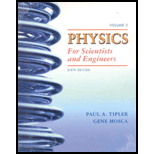
Concept explainers
(a)
The initial upward acceleration of the balloon when it is released from sea level.
(a)
Answer to Problem 52P
Explanation of Solution
Given:
Radius of the balloon
Total mass (mass of the balloon + mass of the helium + mass of the equipment)
Formula used:

FIGURE: 1
In the figure 1,
Let us apply the Newton’s second law, that is
Using Archimedes principle, buoyant force
Applying
Since balloon is in spherical shape, volume of the balloon is,
And hence, buoyant force,
Where,
Substituting for buoyant force in equation
Calculation:
Substituting the numerical values in equation
Conclusion:
The initial upward acceleration of the balloon when it is released from sea level is
(b)
The terminal velocity of the ascending balloon.
(b)
Answer to Problem 52P
Explanation of Solution
Given:
Radius of the balloon
Total mass (mass of the balloon + mass of the helium + mass of the equipment)
Drag force of the balloon is
Where,
Formula used:
Let
Let us apply the Newton’s second law, which is
Substituting for
Calculation:
Substituting the numerical values in equation
Conclusion:
The terminal velocity of the ascending balloon is
Want to see more full solutions like this?
Chapter 13 Solutions
Physics for Scientists and Engineers, Vol. 3
- Enter an expression for the magnitude of the force of the bottom-most parcel on the center parcel valid for any value of the vertical acceleration, ay, using only the parameters provided in the palettearrow_forwardSuppose the horizontal velocity of the wind against a sail is 6.3 m/s parallel to its front surface and 3.5 m/s along its back surface. -Calculate the magnitude of the force on a square meter of sail in N, given that the density of air is 1.29 kg/m3.arrow_forwardOceanographers use submerged sonar systems, towed by a cable from a ship, to map the ocean floor. In addition to their downward weight, there are buoyant forces and forces from the flowing water that allow them to travel in a horizontal path. One such submersible has a cross-section area of 1.3 m2, a drag coefficient of 1.2, and, when towed at 5.1 m/s, the tow cable makes an angle of 30° with the horizontal. What is the tension in the cable?arrow_forward
- Is acceleration due to gravity more or less a top Mount Everest than at sea level ?arrow_forwardPlease determine the required weight of Block A so that Block B will impend upward. The weight of block B is 500N, the coefficient of friction between block B and the inclined floor is 0.4, whereas 0.25 for the fixed drum and the rope. The angle of the inclined floor is 60 with respect to the horizontal plane./arrow_forwardAn object is released from rest while immersed within a fluid. The terminal speed of the object is measured to be 8.34 m/s. What was the speed of the object 1.551 s after being released? Let the resistive force be given by R = -bv (Assume that the gravitational force also acts)arrow_forward
- If the air track wasn't levelled properly the weight and the normal force would no longer cancel. How would the equation Fnet = mh g have to be modified in this case?arrow_forwardSuppose that a projectile of mass m moves in a verticalplane in the atmosphere near the surface of the earth underthe influence of two forces: a downward gravitationalforce of magnitude mg, and a resistive force FR that isdirected opposite to the velocity vector v and has magnitudek v2 (where v = |v| is the speed of the projectile;see Fig. 4.1.15). Show that the equations of motion of theprojectile are mx'' = -kvx' , my'' = -kvy' -mg,arrow_forwardA space station, in the form of a wheel 120 m in diameter, rotates to provide an artificial gravity of 3.00 m/s2 for persons who walk around on the inner wall of the outer rim. Find the rate of the wheels rotation in revolutions per minute that will produce this effect.arrow_forward
- Show that for small changes in height h, such that hRE , Equation 13.4 reduces to the expression U=mgh .arrow_forwardFind the height upto which an insect can crawl up a fixed hemispherical bowl of radius r , the coefficient of friction=(1/3).arrow_forwardWhen a surface is horizontal and only gravity acts on an object, the normal force exerted by the surface is equal to ___________________________. On an inclined surface, when is the normal force equal to zero? ______________________________________ _________________________________________________________________________________________arrow_forward
 Classical Dynamics of Particles and SystemsPhysicsISBN:9780534408961Author:Stephen T. Thornton, Jerry B. MarionPublisher:Cengage Learning
Classical Dynamics of Particles and SystemsPhysicsISBN:9780534408961Author:Stephen T. Thornton, Jerry B. MarionPublisher:Cengage Learning Principles of Physics: A Calculus-Based TextPhysicsISBN:9781133104261Author:Raymond A. Serway, John W. JewettPublisher:Cengage Learning
Principles of Physics: A Calculus-Based TextPhysicsISBN:9781133104261Author:Raymond A. Serway, John W. JewettPublisher:Cengage Learning University Physics Volume 1PhysicsISBN:9781938168277Author:William Moebs, Samuel J. Ling, Jeff SannyPublisher:OpenStax - Rice University
University Physics Volume 1PhysicsISBN:9781938168277Author:William Moebs, Samuel J. Ling, Jeff SannyPublisher:OpenStax - Rice University


